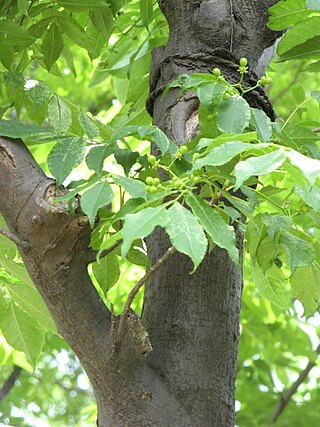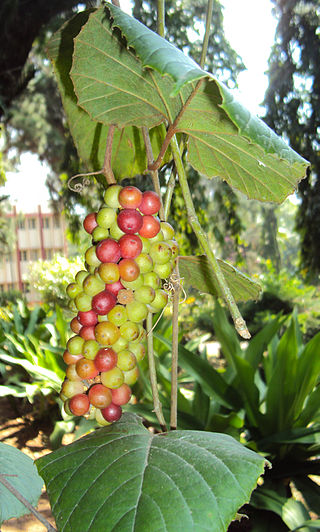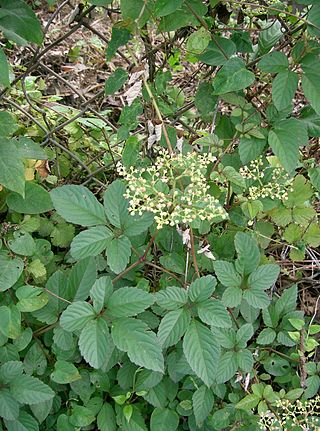
Rosaceae, the rose family, is a medium-sized family of flowering plants that includes 4,828 known species in 91 genera.

The Vitaceae are a family of flowering plants, with 14 genera and around 910 known species, including common plants such as grapevines and Virginia creeper. The family name is derived from the genus Vitis.

Celtis is a genus of about 60–70 species of deciduous trees, commonly known as hackberries or nettle trees, widespread in warm temperate regions of the Northern Hemisphere. The genus is part of the extended Cannabis family (Cannabaceae).

Melicope is a genus of about 240 species of shrubs and trees in the family Rutaceae, occurring from the Hawaiian Islands across the Pacific Ocean to tropical Asia, Australia and New Zealand. Plants in the genus Melicope have simple or trifoliate leaves arranged in opposite pairs, flowers arranged in panicles, with four sepals, four petals and four or eight stamens and fruit composed of up to four follicles.

Trema is a genus of about 15 species of evergreen trees closely related to the hackberries (Celtis), occurring in subtropical and tropical regions of southern Asia, northern Australasia, Africa, South and Central America, and parts of North America. They are generally small trees, reaching 10–20 m (33–66 ft) tall.

Zanthoxylum is a genus of about 250 species of deciduous and evergreen trees, shrubs and climbers in the family Rutaceae that are native to warm temperate and subtropical areas worldwide. It is the type genus of the tribe Zanthoxyleae in the subfamily Rutoideae. Several of the species have yellow heartwood, to which their generic name alludes. Several species are cultivated for their use as spices, notably including Sichuan pepper.

Tetrastigma is a genus of plants in the grape family, Vitaceae. The plants are lianas that climb with tendrils and have palmately compound leaves. Plants are dioecious, with separate male and female plants; female flowers are characterized by their four-lobed stigmas. The species are found in subtropical and tropical regions of Asia, Malaysia, and Australia, where they grow in primary rainforest, gallery forest and monsoon forest and moister woodland. Species of this genus are notable as being the sole hosts of parasitic plants in the family Rafflesiaceae, one of which, Rafflesia arnoldii, produces the largest single flower in the world. Tetrastigma is the donor species for horizontal gene transfer to Sapria and Rafflesia due to multiple gene theft events.

The genus Cayratia consists of species of vine plants, typical of the tribe Cayratieae. Some of them are useful, and they are found in tropical and subtropical areas of Asia, Africa, Australia, and islands of the Pacific Ocean.

Picrasma is a genus of flowering plants in the family Simaroubaceae, comprising six to nine species native to temperate to tropical regions of Asia, and tropical regions of the Americas. The species are shrubs and trees growing up to 20 m tall.

Ampelocissus is a genus of Vitaceae having 90 or more species found variously in tropical Africa, Asia, Central America, and Oceania. The type species, A. latifolia, was originally treated under its basionym, Vitis latifolia, and was collected from the Indian subcontinent.

Causonis japonica is the type species of vine plant in its genus and is native to Tropical and Subtropical Asia, Australia and the West Pacific. It is used as a traditional Chinese medicine to relieve swelling and heat, and to enhance diuresis and detoxification.
Afrocayratia debilis is a species of flowering plant in the grapevine family Vitaceae, native to equatorial Africa. It has herbaceous or slightly woody vines, with 5-foliate leaves and greenish-white to yellow flowers. Its stem, leaves, and sap are used in traditional medicine in various African countries, and the leaves are eaten as a vegetable on the island of Bioko. Its fruits are inedible, although they are fed to poultry in the Central African Republic to protect from influenza and coccidiosis.

Ottelia is a genus of an aquatic plant family Hydrocharitaceae described as a genus in 1805. The genus is native to tropical and subtropical regions of Africa, Asia, South America, and Australia.
Pterisanthes is a vine plant genus in the subfamily Vitoideae. Its native range is Indochina to W. Malesia including the Philippines. The relationship between Pterisanthes and another genus "Nothocissus" with Ampelocissus has been debated, with the latter now subsumed within Ampelocissus, but with Pterisanthes retained.

The Malmeoideae are a subfamily of trees and other plants of the family Annonaceae.

Causonis is a genus of flowering plants belonging to the family Vitaceae; it is now placed in the tribe Cayratieae.
Pseudocayratia is a genus of Asian vine plants in the family Vitaceae. As its name suggests, it was split from the previously configured genus Cayratia, which was found not be monophyletic: for example, Pseudocayratia oligocarpa, from central China to Vietnam, was distinct from Cayratia pedata. Species have been recorded from central-southern China, Japan, the Ryukyu Islands, Taiwan and Vietnam.
Pseudocayratia oligocarpa is a species of Asian vine plants in the subfamily Vitoideae. This species, found from central-southern China to Vietnam, was previously placed in the non-monophyletic genus Cayratia, but these genera are not dissimilar and are now placed in the tribe Cayratieae.
Afrocayratia is a genus of flowering plants in the grapevine family Vitaceae. Its species are found in tropical and southern Africa, Yemen, Mayotte, and Madagascar. It was split off from the non-monophyletic genus Cayratia in 2020.














